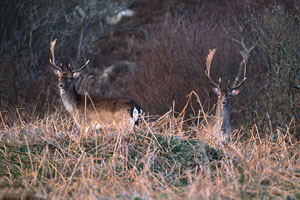By Megan Lock, GWCT Advisor
Over the last few weeks, I have been undertaking breeding bird surveys on the Martin Down Farmer Cluster, just after dawn, walking transects across the farmland recording what I see and hear. But I didn’t just hear and see birds; I also saw lots of fallow deer (Dama dama) too.

Within properly functioning ecosystems, deer play an important role by maintaining open areas, which can enhance the biodiversity and habitat quality of a woodland. However, without numbers being correctly controlled, large deer populations can have a devastating effect on their environment. It is widely known that fallow numbers are increasing, and they are moving around in large herds covering vast tracts of land – this has become quite an issue for farmers and landowners. But where did they come from?
In the UK there are six species of deer. These include red deer and roe deer, which are native, and four introduced species: fallow, muntjac, sika and Chinese water deer. Whilst fallow deer are non-native, they are now considered naturalised and are locally abundant.
According to the British Deer Society, fallow deer were first brought to Britain from the western Mediterranean during the Roman period, where they were kept within enclosures known as ‘vivaria’. Following the collapse of the Roman Empire, genetic analysis has shown that these Roman fallow deer went extinct in Britain. It was not until the 11th Century that fallow deer were reintroduced by the Normans, this time from the eastern Mediterranean.
Originally, fallow deer were kept in parks as rare exotica, but as their populations increased, they became an important source of venison for aristocratic tables. In the 15th Century, the fashion for deer parks declined and many parks fell into disrepair, and these medieval escapee deer are the foundation of the free-living population in Britain today. You can see fallow deer across most of England and Wales (patchy in Scotland), inhabiting mature broadleaf woodland with under-storey, open coniferous woodland, and open agricultural land. They prefer to graze grasses although they will take trees and dwarf shrub shoots in autumn and winter.
I would be surprised if you haven’t seen a fallow deer, as even today they are kept in parkland in famous places like Richmond Park in London and Woburn Abbey, as well as being abundant in numbers naturally in places like the New Forest, agricultural land and even in the middle of an urban areas. But if you haven’t seen one, they are quite unmistakeable. Fallow typically have light chestnut brown coats with white spots in the summer and duller brown in the winters. However, they have four main colour variations – common (tan/fawn with white spotting on flanks and white rump patch outlined with a black horseshoe shape border); menil, which is paler with a chestnut horseshoe; melanistic, which is black or chocolate-coloured; and white, which is a true white rather than albino.
They are medium-sized deer, growing to about 90cm tall. The bucks (male deer) are the only deer species in the UK to have palmate antlers, meaning the antlers have a similar shape to that of a hand with fingers extended, which become full-sized after the deer is three to four years old, and can reach a size up to 0.7m in length. The antlers are shed and regrown every year, becoming increasingly elaborate over the deer’s life.
Outside of the rutting season, which takes place in October, bucks form separate herds away from does (female deer) and young (fawns). But during the rutting season the bucks establish ‘rutting stands’; they thrash foliage and call loudly with grunts and bellows, marking their stand with both scent and slots marks. The rut is a magical time of year, one that reminds me of my childhood. My grandfather used to take me to a special part of the New Forest to go “deer watching” every year. We would get nestled down in the bracken at a distance not to disturb natural behaviour and watch the bucks chasing the does about with our binoculars, listening to them grunting and fighting with other males. I still go to that place every year, but now with my husband and daughter to pass on the tradition.
After the all the chaos of the rutting season is over, the does give birth to a single fawn after a 230-day gestation in June/July, which will be able to breed after a year. So, keep an eye out for a fawn from now – you might be lucky enough to catch a glimpse of one while you are out and about. And if you do, remember to look, but don’t touch!
Please help our team continue their vital conservation research by giving what you can. All payment cards, PayPal, Apple Pay and Google Pay accepted.
